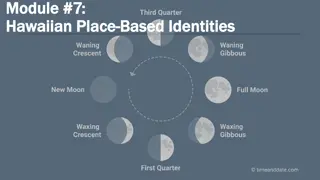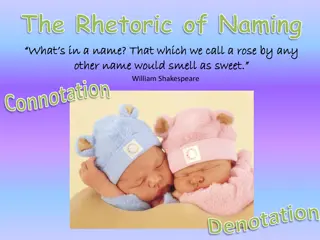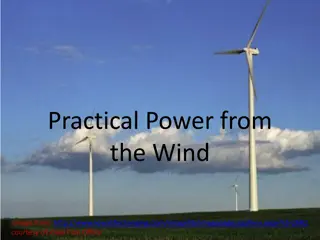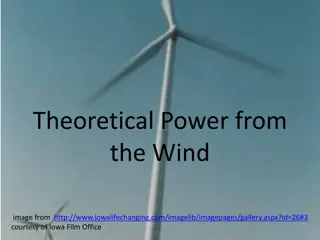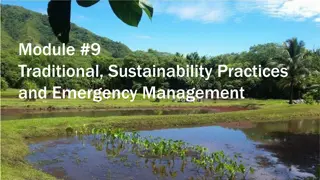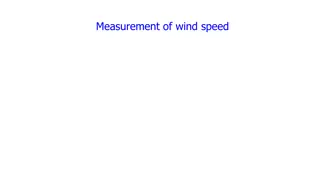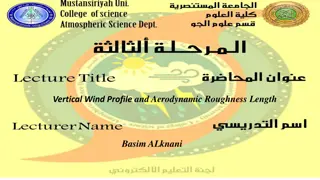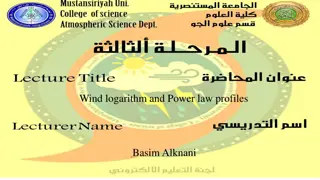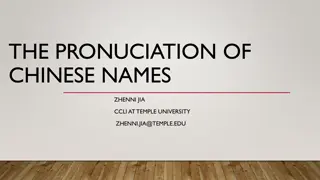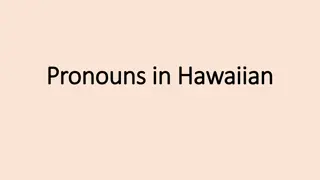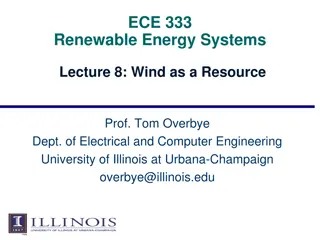Understanding Hawaiian Wind Names and Emergency Management
Explore the significance of Hawaiian wind names, cultural protocols, and their connection to Emergency Management through activities, storytelling, and understanding the winds' role in Hawaiian identity and climate change. Delve into the legends of La amaomao and discover the spiritual importance of winds in Hawaiian tradition.
Download Presentation

Please find below an Image/Link to download the presentation.
The content on the website is provided AS IS for your information and personal use only. It may not be sold, licensed, or shared on other websites without obtaining consent from the author. Download presentation by click this link. If you encounter any issues during the download, it is possible that the publisher has removed the file from their server.
E N D
Presentation Transcript
Module #8 Hawaiian Wind Names and Emergency Management Add image here 1
Learning Objectives Participate in an activity that is inclusive and collaborative. Show how each member of your group is contributing to the team and community. Reclaim Hawaiian identity through understanding winds & directional points through ike ku una (Hawaiian knowledge, belief system, philosophy, and practices). Perpetuate ike ku una in order to form a Hawaiian foundation for the la hui (Nation). Understanding how winds can contribute to Emergency Management Plans. 2
Needs to Know Where does the sun rise and set? Where is the East and West? What are the names to the winds in that area and/or family Ahupua a? What is the ike ku una and ike ku puna about the significance of the winds? How is the wind connected to Emergency Management? How did my kupuna show appreciation to this ike? How is the wind important in the bigger picture of Climate Change? 3
Module Sections Station 3: Wind Names Cultural protocol Benefits of knowing the wind Introductions Activity Group Activity: Gather to Share Mo olelo of La amaomao Case Study Information on La amaomao & the Wind Gourd Additional references Re-tell the mo olelo Oli Mahalo Mo olelo and Critical Dialogue Group Activity: Winds of Maui Station 1: Wind Descriptions 4 Station 2: Wind Characteristics
Cultural Protocol Elder and/or leader to start beginning protocol to have everyone on the same page. Words to E H Mai (By: Edith Kanaka ole Kanahele) E h mai ka ike mai luna mai O n mea huna no eau o n mele E h mai, e h mai, e h mai (x3) 5
Introductions Each person introduces themself and where they are from in the Hawaiian language. Each person explains what connects them to this place. Follow below: Aloha. O (first & last name) ko u inoa. No (place of residence) mai au. What makes me pili to Hawaii? 6
Mo Mo olelo olelo of of La La amaomao amaomao In legends, it is believed that there was a wind gourd that could summon these winds upon chanting for them. The gourd represents the God Lono and the guardian of the gourd is called La amaomao. La amaomao was the name of Mo ikeha s crewmember that sailed back and forth with Mo ikeha as the person that called out to the winds. This gourd today can be found at the Bishop Museum collection and has an inscription [that] reads.... The wind gourd of La amaomao that was in the keeping of Hauna, personal attendant of Lonoikamakahiki I [Keawenuia umi s youngest son]. It was passed on to Paka a, a personal attendant of Keawenuiaumi. It was placed in the royal burial cave of Hoaiku on the sacred cliffs of keoua, at kaawaloa, island of Hawaii, and received by King Kalakaua I on January 1, 1883, from Ka apana, caretaker of Hoaiku. (Kawaharada 2) 7
Information on Information on La La amaomao amaomao and the Wind Gourd and the Wind Gourd This wind gourd was donated to the Bishop Museum by Princess Kalaniana ole in 1923 where it sits in the basement in a cold room. It is another testament that traditional sites hold pieces of knowledge that can explain the phenamena of the world. The wind can also be seen on the ocean pathways as the water is disturbed by the wind interacting with the ocean. What can be felt by using your face to feel the wind can also seen on top of the ocean pathways. One of many examples is the wind channel that can be seen from an advantage point on Kaho olawe at Kealaikahiki as the Kealaikahiki(same name) ocean channel follows in the same direction. The wind path can be seen on the water when the wind is blowing over 10mph. 8
Re Re- -tell the tell the Mo Mo olelo olelo Where does the story take place? Who are the people involved? What was one thing from the mo olelo that you remembered in the: Beginning Middle End 9
Mo Mo olelo olelo & Critical Dialogue & Critical Dialogue Why is the mo olelo important to Hawaiian people? How does this mo olelo connect to Emergency Management? Is it important to understand the elements of reference in Emergency Management? In this case, referring to the winds. What are other examples from other native cultures that are similar? How does mo olelo help to understand another worldview? What are other dynamics to note regarding mo olelo of a native culture and modern day management plans? 10
Group Activity Group Activity Each group will have 4 or 5 people. Each group to go through Station 1, 2, & 3 together. (The stations are outlined in following slides). Look for the common denominator in each group. Each name and/or description has a mo olelo and/or directional marker of each wind. Why is this important? How does this connect to Emergency Management? 11
Winds of Maui Winds of Maui 12
Station Station 1 1: Wind Descriptions : Wind Descriptions A e northeast tradewind. Kaia ulu pleasant, gentle tradewind breeze. Kaumuku wind squall. Kiu strong, cold northwesterly wind. Ku strong Moa e tradewind. Kualau shower accompanied by seawind. Moa ea e tradewind. Pu ewai a cold wind. 13
Station Station 2 2: Wind Characteristics : Wind Characteristics A ala Loloa wind name; A e Loa name for the tradewind; Ahe (aheahe) softly blowing; light gentle breeze; Ahe kolo gentle-moving breeze; A la i gentle as a breeze; Ena makani stormy wind. Ha ao a wind driving rain; Hau a cool breeze; Hauna I loli wind name; Haunone name of a cold wind; Hau oki frost, ice, cold, icy wind; Hihio draft or gust of wind; Hinale a to blow favorably, as wind; Hio a sweep or gust of wind; to blow in gusts; Hoene to sound softly, rustle, to sound softly, as the wind; Holomakani breezy, airy; Ho oheu name of strong wind threatening to gale; Ho olua a strong north wind; Huehu name of a strong northwesterly wind of the winter months. (PE:85) Inuwai a sea breeze (Lit. water drinking). 14
Station Station 2 2: Wind Characteristics (continued) : Wind Characteristics (continued) Ka kea name of a strong wind; Kala ia kea wind name; Kalio a gusty breeze; Ka lu u to sweep and swerve as a gust of wind; Kauahae wind name; Kanoenoe to blow, of the tradewind; Kauaheahe gentle as breeze, light; Ki ki ao sudden wind gust, squall; Kilipoe wind name; Kiu strong, moderately cold northwesterly wind; Kiuwailehua a cold wind (Lit. Ki of the lehua honey); Ko aheahe blowing gently as the wind; Ko aniani to waft as a soft cooling breeze; Kohai to sway in the breeze, as a tree; Kokololio also kololio sharp, swift wind gust; Kokolowini sharp, penetrating wind or gust; Kolo to creep, crawl; to move along, as a gentle breeze or shower; Kolonahe gentle, pleasant breeze. (Lit. gentle creeping)l Kolopu epu e wind name; Kona wind on the leeward side of the island; Kona Hea name of a cold Kona storm; Kona Hili Mai a name of a Kona wind with protracted rains; Koa ku Kona wind with heavy rain; Kona Lani Kona wind with slight showers; Kona Mae a cold Kona wind (Lit. withering Kona); Konanuianiho a strong Kona storm (Lit. great Kona that bites teeth). 15
Station 3: Wind Names Wind Names Aha aha gentle breeze from Waihe e to Niua Point; A a same as the Ma a a wind at Lahaina; A e northeast tradewind; Ailoli wind at Kaupo (Lit. sea cucumber eating); Aimaunu wind (Lit. bait eating) at Ha na; Akipohe wind at Waihe e; Alau east wind at Ha na; Apiolopaowa wind at Ha na; Halemau u wind at Ha na (Lit. grass house); Hau cool breeze at Kula; Ho olua strong north wind from the ocean at Ha na; Hulialopali wind at Lahaina (Lit. turn to the face of the cliff); I aiki wind at Wailuku and Ha na (Lit. little fish); Imihau stormy west wind (Lit. dew seeker) at Keka a and Lahaina; Kaia ulu pleasant, gentle tradewind breeze.; Kaomi northeast tradewind at Ha na; Ka pae tradewind at Ha na; Ka ua ula strong destructive mountain wind at Lahaina (Lit. the red rain referring to red soil washed away by a storm). Ka ula wind at Po hakuloa.; Kaumuku wind squall; Ke hau gentle land breeze at Kula; Kili o opu wind at Waihe e; Kilipohe wind at Iao; Kiu strong, cold northwesterly wind; Kohola lele wind (Lit. leaping whale) blowing from east to west at Ha na and Ki pahulu; also called Kohola pehu; Kololio wind at Ki pahulu; also at Waikapu; Kona wind at Ha na; Ku strong Moa e tradewind; Kualau shower accompanied by seawind; Kui wind at Ha na; Ku lo lio wind of Ha ma kua, East Maui; 16
Station 3: Wind Names Wind Names Lau awa awa (Lau awa) gentle wind at Ha na; Lauko wai wind at Kekula (Lit. water dragnet); Li li lehua wind at Waiehu (Lit. lehua chill); Ma a a famous sea breeze at Lahaina; Makakena wind at Mikimiki; Malanai gentle breeze at Ha na; Moa e tradewind at Kahikinui; Moa ea e tradewind; Nahua wind at Ka anapali; Na u wind at Kula; Na ulu sea breeze at Kanaloa, Ma kena; Olaukoa wind at Ukumehame, Olowalu; O opu wind at Waihe e; Pa ala wind at Ma kaha, Kahakuloa, West Maui; Paiolopaowa inland wind at Ha na; Pa kololiokaia ulu wind at Kea lia, Kihei; Papa wind at Honua ula, Ma kena; Po hakea wind at Ma hinahina, Honolua, Lahaina district;Pu ewai a cold wind; U kiu chilly north wind at Makawao and Pi iholo; Ulalena wind at Pi iholo (mountain at Ha iku ); Ulumano wind at Punahoa; Unuloa a wind also in Puna, Hawai i; Wai uli wind at Honolua, Lahaina; Wa wahihale wind at Olowalu; Wehelaunu wind at Ma la, Lahaina. 17
Benefits of Knowing the Wind Benefits of Knowing the Wind Connection to ike Hawai i (Hawaiian Knowledge). Connection to ina (land). Connection to a different worldview that is in sync with nature. During times of Emergency Management, understanding the wind is crucial in putting together a management plan for safety, disaster relief, & eco-friendly options. Wind directions in the Hawaiian mo olelo and language is informed from centuries of ancestral knowledge that has experienced some type of disaster event. Through mo olelo the solutions at that time are given and passed down through these stories to allow for a continuation of ike Hawai i (Hawaiian knowledge) to emergency situations. 18
Group Activity: Gather to Share Group Activity: Gather to Share What are some things that stood out to you or questions you have about what you shared? How is Hawaiian knowledge beneficial to Emergency Management through examples of knowing about the winds? What does this mean for your work? What changes might you need to make this example? What kinds of support might you need? How can all of us here today ensure that the information shared is used and refined to have a positive impact on your emergency management system? 19
Case Study Case Study Yeng, Yeng & Yi-Leng Chen. Circulations and Rainfall on the Lee Side of the Island of Hawaii during HaRP. American Meteorological Society. Volume 131, Issue 10. October 01, 2003. 1-18. Read the article and discuss the following questions as a group. How does Hawaiian knowledge of the winds prepare a person/group/organization for disaster/emergency/management? How can Hawaiian knowledge be added to this research in the case study for a more thorough conclusion? 20
Oli Mahalo Thank Thank you you chant chant in Hawaiian Language: in Hawaiian Language: English Translation: English Translation: Uhola ia ka makaloa l P ai i ke aloha l K ka i ia ka h loa l P wehi mai n lehua Mai ka ho oku i a ka h l wai l Mahalo e Ke Akua* Mahalo e n kupuna l e Mahalo me ke aloha l Mahalo me ke aloha l The makaloa mat has been unfolded Food is shared in love The great breath is exchanged The Lehua honors and adores From zenith to horizon Gratitude to God Gratitude to our ancestors Gratitude with love Gratitude with love 21
References: References: Kawaharada, Dennis. "Introduction to The Wind Gourd of La amaomao." 1992. Retrieved October 02, 2018 from website: www.2.hawaii.edu/~dennisk. Nakuina, Moses Kuaea. The Wind Gourd of Laamaomao. CreateSpace Independent Publishing Platform, 2016. Kirch, Patrick. On the Road of the Winds: an Archaeological History of the Pacific Islands before European Contact. University of California Press, 2017. Fornander, Abraham. "Hawaiian Antiquities and Folk-Lore; The Hawaiians' Account of the Formation of their Islands and Origin of their Race, with the Traditions of their Migrations, Etc., as Gathered From Original Sources. Kamahualele s chant. Mo ikeha story." Bishop Museum Press, vol. IV, 1918, pp. 12-128. doi: 10.1038/107391c0. 22






